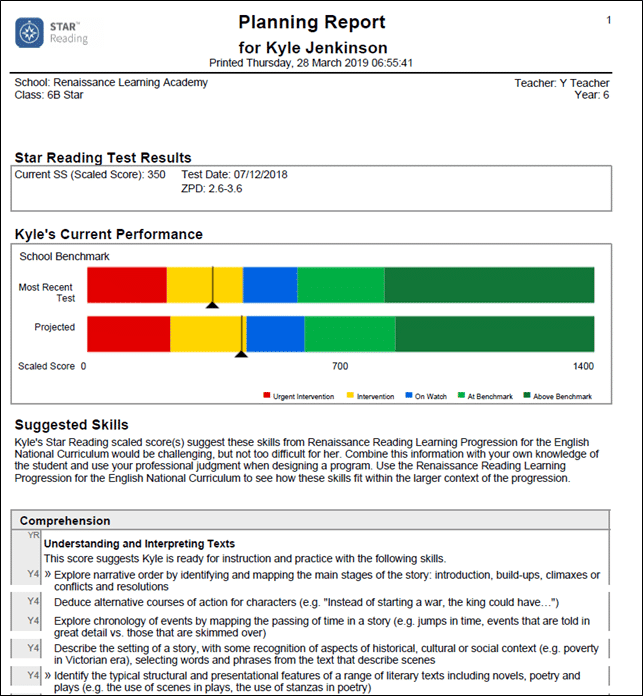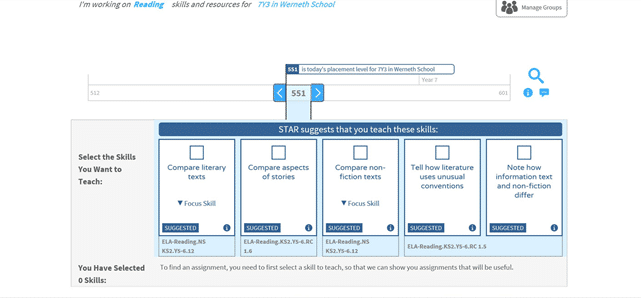July 15, 2021
The school year 2021/22 will again be challenging with students and their teachers managing the impacts of so much disruption over two school years. This situation is indeed ‘unprecedented’ but we know that school’s are determined to get everyone back on track, working hard and enjoying learning. Star Assessments can contribute to this and here, assessment publisher, Sue Thompson highlights some of the valuable and in some cases unique ways these assessments can support planning, teaching and learning in the year to come.
Must-have Metrics
September is when school’s use formal assessment very widely to create a baseline, evaluate any post-holiday ‘dip’ and help with setting. But what, among the plethora of scores, analysis and correlations are the must-have metrics for this coming year?
Importantly Star Assessments are standardised and provide a range of information, including national benchmarks. So, an ideal basis for tracking progress, whether starting from scratch this September or continuing with your established assessment routine. Furthermore, because of the process undertaken to produce nationally representative data over time, you can be confident in making valid judgements for your students based on the assessment outcomes.
A Quick Recap
The Norm-Referenced Standard Score (NRSS) provides an all-important comparison to students across the country. This comparison allows teachers to see how your students’ reading and maths attainment ranks with all students following a similar curriculum.
To reinforce this, you will see a Percentile Rank for each student to gauge where they fit in relation to their peers nationally. The Age Equivalent Score or Reading Age from Star Reading is a handy reference and ideal for discussing assessment outcomes with parents and carers. The Zone of Proximal Development (ZPD) allows you to support students’ reading for pleasure in school and at home.
Star Specials
Here, however, I want to highlight two scores that are unique to Star Assessments and will be especially relevant from September:
The Scaled Scored represents the difficulty of the test questions. It allows you to see absolute progression, even when other adjusted scores appear static. This score is tailored to Star Assessments and results from complex statistical processes that also support computer adaptivity. Practically, the Scaled Score is vital in refining the Instructional Planning Report when it comes to reporting. You can group students within a range of scaled scores to see what they need to learn next. (We’ll be looking at this report in the next blog.)
The Student Growth Percentile measures student progress in the context of students within the same percentile rank. When viewed across a class or year group, you will see who has made good progress from their unique starting points. The two cases below illustrate progress in the context of starting points.
Case study 1: Sarah
| Date of test | SS | NRSS | PR | RA | ZPD | SGP |
| 07/07/18 | 665 | 104 | 66 | 11.02 | 4.1-6.3 | 57 |
| 26/04/19 | 770 | 109 | 76 | 12.01 | 4.3-6.8 |
Sarah’s NRSS has improved between test points (seven months apart), but this metric does not show a significant improvement. However, her reading age has been enhanced by 11 months, signifying a four-month gain over these seven months.
The ZPD does not imply the need to change focus for Sarah’s engagement with Accelerated Reader.
However, we can use the Scaled Score to demonstrate that Sarah has answered questions of increasing difficulty.
Her SGP demonstrates that she has made slightly better progress than her peers with similar starting scores, but it puts her in the average range (35 to 65).
Case study 2: Lana
| Date of test | SS | NRSS | PR | RA | ZPD | SGP |
| 14/09/18 | 490 | 93 | 35 | 9.09 | 3.2-5.0 | 67 |
| 30/04/19 | 608 | 97 | 47 | 10.09 | 3.8-5.9 |
Lana’s NRSS is slightly below the national mean but securely within the average range at both test points. Statistically, the gain is not significant; her performance is consistent, and her progress appears average.
Again, the Scaled Score shows that at the second test point, Lana has answered more complex questions.
However, the most encouraging metric in this report is the SGP. It shows that Lana is in the top 33% of students for progress compared to her peers and that although her scores across the board are lower than Sarah’s, her growth is higher.
Working with the Scaled Score and monitoring progress using the Student Growth Percentile will mean that maximum benefit is derived from using Star Assessments from September 2021.
Intervention
Reviewing data is important, but at the end of the day it is what we do with the data, how we interpret the scores that will help students.
Knowing that a student’s attainment is ‘average’ is helpful, but a number doesn’t tell us what to do to raise this attainment. Where student attainment is below average or low, it is perhaps even more critical to understand how to help.
Learning Progressions are at the core of Renaissance Learning’s mission to accelerate learning. Awareness of Learning Progressions can support you in tailoring teaching and learning to focus on the most critical skills for accelerated learning for all.
Learning Progressions, reported in the Instructional Planning Report, can start this process by identifying the precise level each student has attained and what, from the vast range of skills set out in the National Curriculum, are key to driving progress.
Figure 1 – Star Reading – Instructional Planning Report

Research has shown that learning to perform specific tasks happens consistently over a predictable amount of time. Students’ thinking becomes more sophisticated as they respond to teaching and experience in and out of school. Learning progressions reflect this typical process.
Renaissance has been working with Learning Progressions in reading and maths for over a decade. The value of Learning Progressions led to the commissioning of the National Foundation for Educational Research to produce Learning Progressions for Star Assessments based on the English National Curriculum.
The starting point was to expand and translate requirements in the Curriculum into teachable skills. Although the Programmes of Study define teaching content, they do not always specify all the steps in learning that a student must master to progress.
Learning Progressions detail how knowledge and skills in the National Curriculum typically develop.
This process produced a long list of skills for teaching and learning. The further analysis delivered Focus Skills – those without which students cannot progress. In turn, the Instructional Planning Report from Star Assessments now incorporates these Focus Skills. Focus Skills take care of some of the heavy lifting. They are an iterative process that can start as soon as students have been assessed in September and for every subsequent assessment.
Figure 2 – Reading Dashboard – Focus Skills

You can find a complete description of Learning Progressions here.
